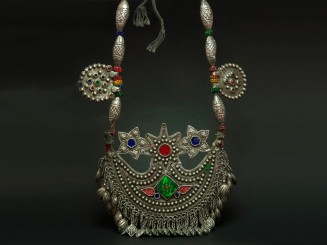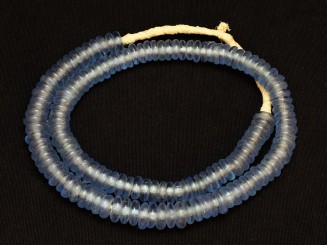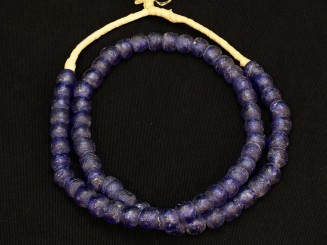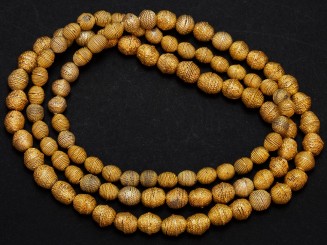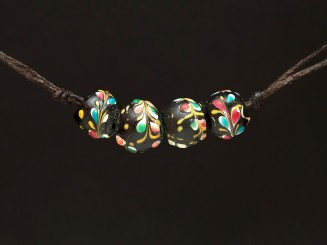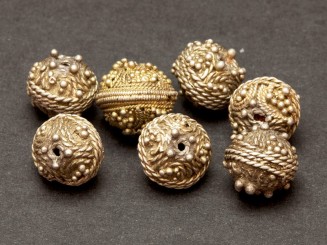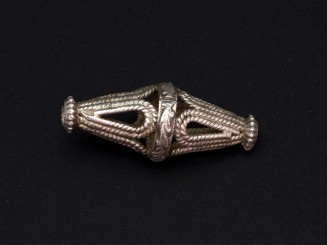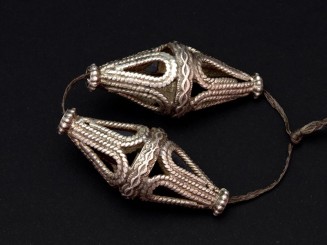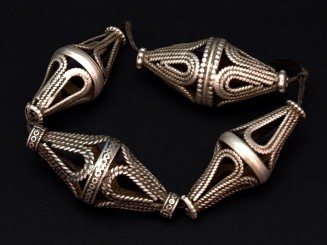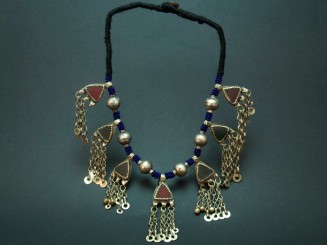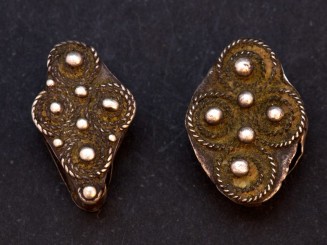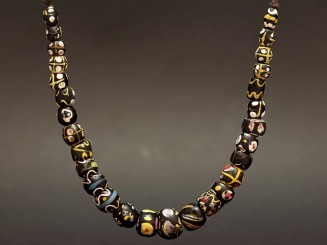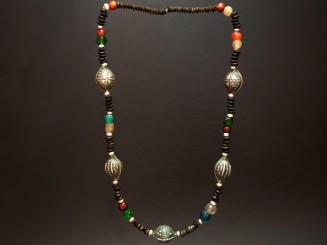
Jewels
-
Price €1,250.00PK1111-558
A magnificent old Kuchi silver and glass necklace. This piece is an excellet sample of jewellery from that ethnic group. It is made of silver, glass cabochons and other tiny beads. Superb patina and piece. The real thing and certainly not one of the modern version on offer nowadays. The Kuchi people, from the Persian -koch- meaning migration, are Afghan pastoons nomads divided in a number of tribes that inhabit areas of Afghanistan and, to a lesser extent, Pakistan. Early XXth century.
-
Price €2,265.00PK1111-557
A superb silver and enamel necklace from the Hazara, an ethnic minority group of persian origin that lives in central and Northeastern Afghanistan and in Northwestern Pakistan. This necklace features three flat silver plaques beautifully enameled in two different shades of blue and red with plant decoration. Sadly the technique for the making of these quality pieces has faded. The ensemble also includes nice silver beads and tiny blue, white and green glass beads which make the arrangement extremely attractive. A trip to the "Arabian Nights". The silver plaques are form the second half of the XIXth century and the arrangement more recent.
-
Price €59.00MA0611-561
There are not many examples of beadwork weaving among the Berbers, this labor is much more frequent in sub-Saharan Africa. This beautiful pectoral necklace comes from the Taza region in the Moroccan Middle Atlas.
-
Price €29.00BC0318-607
A lovely necklace made of old recycled -pâte de verre- discs from Ghana.
-
Price €29.00BC0318-601
A lovely necklace made of old recycled -pâte de verre- discs from Ghana.
-
Price €29.00BC0318-608
A lovely necklace made of old recycled -pâte de verre- discs from Ghana.
-
Price €29.00BC0318-610
A lovely necklace made of old recycled -pâte de verre- discs from Ghana.
-
Price €25.00BC0318-588
A lovely necklace made of old recycled -pâte de verre- beads from Ghana.
-
Price €25.00BC0318-569
A lovely necklace made of old recycled -pâte de verre- beads from Ghana.
-
Price €25.00BC0318-567
A lovely necklace made of recycled glass beads -pâte de verre- from Ghana.
-
Price €270.00BC0417-048
A Very original set of one hundred and two vintage gilding bath silver beads from the skillful hands of a Mauritanian artisan. Uniques!
Avarage diametre between 5 and 7mm
-
Price €39.00BC0417-047
Three superb vintage biconic gilding bath silver beads from Mauritania. Made by lace filigree. Very original!
Average measures 22mm long by 8mm diameter.
-
Price €66.00BC0417-046
Four beautiful vintage bi-conical tabular gilding bath silver beads featuring granulated filigree work decoration. Very original!
Average size 23x11x6mm
-
Price €350.00BC0417-043
Superb gilding bath silver beads necklace. It features the characteristic and intricate granulated and filigree decoration of the Mauritanian goldsmiths. Second half of the 20th century.
Central bead measures 17mm in diameter and the smallest 7mm.
-
Price €48.00BC1215-652
A set of four joyful lamp work Venetian fiorà trade beads from the first half of the XIXth century. Their name comes from their characteristic floral or flower decoration that in a captivating array of colors and motifs is distributed on the main body of the bead which, in this particular case, is of a nice opaque black color.
Approximate dimensions (larger bead): 12mm x Ø14mm.
Also referred to as decorated fancy beads, fiorate or fiorà, these Venetian lamp work glass trade beads are amongst the most attractive we may find. Their main feature is their flamboyant and joyful floral or flower decoration using a rich variety of colors and patterns: feather, bow tie, bouquet, dots, spiral (here we have to mention the well-known Lewis & Clark beads named after the explorers who first traded them with the tribes they found on their expedition from the East to the West coast of the United States in the early 1800s), linear, filigree, etc. They were mainly produced as from the first half of the 19th century. They are usually round or oval shaped.
We use the term trade beads to refer to the European made glass beads that were used by the European merchants and explorers in the trade in Africa as from the 15th century and continued during their colonial expansion.The history of trade beads in Africa takes us then to the 15th century and the arrival of the European, mainly the Portuguese, to the coasts of West Africa. The European discovered quite soon how much the people they met there fancied beads and saw they an opportunity for trade. Amongst the beads that captivated the African people most were glass beads since the techniques for their making had not yet been developed locally. The locals fell for the precious and colorful glass beads such as Venetian millefiori or chevron beads that the European traders had on offer and bartered them for commodities such as precious woods, ivory, gold and even used, ignominiously, in the slave trade. The increasing demand in Africa of European made glass beads continued quite until the first half of the 20th century and it had a boosting effect in the production in cities such as Venice which glass beads became very popular and coveted.
-
Price €265.00AC0616-638
A superb strand of sixty eight trade glass biconical beads, most of them are “eye beads” inspired on the much more ancient Islamic type, and five of them with linear decoration are the so called “King beads” by English merchants or Gololo by West Africans. These types of beads were made in Venice as from the beginning of the XIXth century using the lamp work technique. They were made in a variety of colors combining an opaque glass, solid color core (yellow, burgundy, black, green, etc.). These beads were among the most important ones in the gold trade in Africa.
The biggest bead is 16mm long and 23mm diameter and the smallest 10mm by 12mm.
We use the term trade beads to refer to the European made glass beads that were used by the European merchants and explorers in the trade in Africa as from the 15th century and continued during their colonial expansion. The history of trade beads in Africa takes us then to the 15th century and the arrival of the European, mainly the Portuguese, to the coasts of West Africa. The European discovered quite soon how much the people they met there fancied beads and saw they an opportunity for trade. Amongst the beads that captivated the African people most were glass beads since the techniques for their making had not yet been developed locally. The locals fell for the precious and colorful glass beads such as Venetian millefiori or chevron beads that the European traders had on offer and bartered them for commodities such as precious woods, ivory, gold and even used, ignominiously, in the slave trade. The increasing demand in Africa of European made glass beads continued quite until the first half of the 20th century and it had a boosting effect in the production in cities such as Venice which glass beads became very popular and coveted.
Lamp working is one of the main techniques for the making of glass beads. Lamp or lamp work beads were made using glass canes that were reheated to a temperature of up to 1000 ºC by means of a blowtorch or blowlamp and which were then wound onto a coated iron rod to avoid the molten glass from sticking to the metal. The beads produced by the artisan by these means could be then further decorated by re-heating the bead using the same lamp work method and applying colored glass rods or glass cane inserts to the surface of the bead creating an endless variation of patterns and making of each bead one of its own.
-
Price €265.00AC0616-637
Lovely strand of fifty seven trade glass biconical beads. These type of beads were made in Venice as from the beginning of the XIXth century using the lamp work technique. They were made in a variety of colors combining a opaque glass solid color core (yellow, burgundy, black, green, etc) on which linear decoration was applied in a lively combination of colors. These beads were known in the trade a “King beads” and also, locally, as Gololo beads. These beads were among the most important ones in the gold trade in Africa.
The biggest bead is 20mm long and 22mm diameter and the smallest 12mm by 13mm.
We use the term trade beads to refer to the European made glass beads that were used by the European merchants and explorers in the trade in Africa as from the 15th century and continued during their colonial expansion. The history of trade beads in Africa takes us then to the 15th century and the arrival of the European, mainly the Portuguese, to the coasts of West Africa. The European discovered quite soon how much the people they met there fancied beads and saw they an opportunity for trade. Amongst the beads that captivated the African people most were glass beads since the techniques for their making had not yet been developed locally. The locals fell for the precious and colorful glass beads such as Venetian millefiori or chevron beads that the European traders had on offer and bartered them for commodities such as precious woods, ivory, gold and even used, ignominiously, in the slave trade. The increasing demand in Africa of European made glass beads continued quite until the first half of the 20th century and it had a boosting effect in the production in cities such as Venice which glass beads became very popular and coveted.
Lamp working is one of the main techniques for the making of glass beads. Lamp or lamp work beads were made using glass canes that were reheated to a temperature of up to 1000 ºC by means of a blowtorch or blowlamp and which were then wound onto a coated iron rod to avoid the molten glass from sticking to the metal. The beads produced by the artisan by these means could be then further decorated by re-heating the bead using the same lamp work method and applying colored glass rods or glass cane inserts to the surface of the bead creating an endless variation of patterns and making of each bead one of its own.
-
Price €265.00AC0616-636
Lovely strand of sixty three trade glass biconical beads. These type of beads were made in Venice as from the beginning of the XIXth century using the lamp work technique. They were made in a variety of colors combining a opaque glass solid color core (yellow, burgundy, black, green, etc) on which linear decoration was applied in a lively combination of colors. These beads were known in the trade a “King beads” and also, locally, as Gololo beads. These beads were among the most important ones in the gold trade in Africa.
The biggest bead is 16mm long and 18mm diameter and the smallest 12mm by 12mm.
We use the term trade beads to refer to the European made glass beads that were used by the European merchants and explorers in the trade in Africa as from the 15th century and continued during their colonial expansion. The history of trade beads in Africa takes us then to the 15th century and the arrival of the European, mainly the Portuguese, to the coasts of West Africa. The European discovered quite soon how much the people they met there fancied beads and saw they an opportunity for trade. Amongst the beads that captivated the African people most were glass beads since the techniques for their making had not yet been developed locally. The locals fell for the precious and colorful glass beads such as Venetian millefiori or chevron beads that the European traders had on offer and bartered them for commodities such as precious woods, ivory, gold and even used, ignominiously, in the slave trade. The increasing demand in Africa of European made glass beads continued quite until the first half of the 20th century and it had a boosting effect in the production in cities such as Venice which glass beads became very popular and coveted.
Lamp working is one of the main techniques for the making of glass beads. Lamp or lamp work beads were made using glass canes that were reheated to a temperature of up to 1000 ºC by means of a blowtorch or blowlamp and which were then wound onto a coated iron rod to avoid the molten glass from sticking to the metal. The beads produced by the artisan by these means could be then further decorated by re-heating the bead using the same lamp work method and applying colored glass rods or glass cane inserts to the surface of the bead creating an endless variation of patterns and making of each bead one of its own.
-
Price €560.00AC0616-635
A superb collection of fifty-six rosetta or chevron glass beads of two, three and four layers made with star-shaped cross section cane insets with external stripes in two and three colors and in some cases finished with a final layer of transparent glass. These beads were manufactured in Venice from the early nineteenth century and would have been employed in West Africa in the trade of gold and palm oil.
The largest of the beads is 17mm in diameter and 15mm in length and the smallest is 8 by 8mm.
European glass chevron trade beads were certainly the first to be traded in Africa as early the 15th century. They show a very characteristic “rosetta” o “star” layered decoration attained by giving form to glass in star shaped moulds. Layer after layer are applied to form a cane which is then cut in cylinders and ground to show the alternated chevron or star layers. They were first produced in the Venetian island of Murano at the Barovier glass factory. The rarest examples are very much coveted and they are quite commonly tagged by the number of layers they show.
We use the term trade beads to refer to the European made glass beads that were used by the European merchants and explorers in the trade in Africa as from the 15th century and continued during their colonial expansion. The history of trade beads in Africa takes us then to the 15th century and the arrival of the European, mainly the Portuguese, to the coasts of West Africa. The European discovered quite soon how much the people they met there fancied beads and saw they an opportunity for trade. Amongst the beads that captivated the African people most were glass beads since the techniques for their making had not yet been developed locally. The locals fell for the precious and colorful glass beads such as Venetian millefiori or chevron beads that the European traders had on offer and bartered them for commodities such as precious woods, ivory, gold and even used, ignominiously, in the slave trade. The increasing demand in Africa of European made glass beads continued quite until the first half of the 20th century and it had a boosting effect in the production in cities such as Venice which glass beads became very popular and coveted.
-
Price €39.00MA0905-740
A lovely Moroccan Berber old silver plaque with beatiful incise decoration. Pieces like these were sewn in rows on textile or leather pieces making beautiful headbands. They were often combined with some other elements such as coral, amzonite, silver coins, trade beads to a most flamboyant result.
-
Price €39.00MA0905-741
A lovely Moroccan Berber old silver plaque with beatiful incise decoration. Pieces like these were sewn in rows on textile or leather pieces making beautiful headbands. They were often combined with some other elements such as coral, amzonite, silver coins, trade beads to a most flamboyant result.
-
Price €125.00MA1016-588
Seven outstanding silver old beads with traces of gilding bath. Featuring an intricate work of granulation and filigree very characteristic of Mauritanians goldsmiths. Very rare to find especially in good condition. Beautiful patina. Beginning of the 20th century
-
Price €125.00MA1016-587
Six outstanding silver old beads with traces of gilding bath. Featuring an intricate work of granulation and filigree very characteristic of Mauritanians goldsmiths. Very rare to find especially in good condition. Beautiful patina. Beginning of the 20th century
-
Price €225.00MA1016-586
Sixteen outstanding silver old beads with traces of gilding bath. Featuring an intricate work of granulation and filigree very characteristic of Mauritanians goldsmiths. Very rare to find especially in good condition. Beautiful patina. Beginning of the 20th century
-
Price €180.00MA1016-585
Fifteen outstanding silver old beads with traces of gilding bath. Featuring an intricate work of granulation and filigree very characteristic of Mauritanians goldsmiths. Very rare to find. Beautiful patina. Beginning of the 20th century
-
Price €195.00MA1016-558
Ten precious silver old beads with traces of gilding bath. Featuring an intricate work of granulation and filigree very characteristic of Mauritanians goldsmiths. They are used as part of necklaces and they can also be seen decorating the haird of Maure ladies. This kind of beads are very scarce nowadays. Beautiful patina. Beginning of the 20th century.
4 pieces 15 mm high, 4 pieces 17 mm high, 1 piece 18 mm high y 1 piece 20 mm high.
-
Price €32.00MD0913-333
Beautiful Afghan old oval silver bead featuring a great silver openwork and a great patina. Superb patina.
-
Price €75.00MD0913-334
Beautiful Afghan old oval silver beads featuring a superb silver openwork and a great patina.
-
Price €124.00MD0913-337
Beautiful Afghan old oval silver beads featuring a superb silver openwork and a great patina.
-
Price €48.00MD1214-044
A vintage Kuchi necklace from Afgahistan made of mixed metals beads and great glass pendants. The Kuchi people, from the Persian -koch- meaning migration, are Afghan pashtoons nomads divided in a number of tribes that inhabit areas of Afghanistan and Pakistan. Medium, size.
-
Price €55.00MD1115-511
A superb pair of antique Mauritanian silver beads showing the typical granulation and silver beads with that provenance. They are used as part of necklaces and they can also be seen decorating the hairdo of Mauritanian ladies. This kind of beads show quite often gilded decoration though, in this particular case, it is diificult to say if they were ever gilded as the passing of time would have erased any traces. Wonderful patina.
-
Price €165.00MD0316-312
To make up this beautiful strand of tenty-eight Venetian trade lampwork glass beads from the XIXth centurty we have had to collect them in Mali, Mauritania and Morocco. And the truth is that we are very happy about the result which pays tribute to the imagination and creativity of Venetian glass artisans. These glass beads are like little gems or candies that cannot but coveted. This strand mixes a lovely variety of fancy decorated beads, including eye beads, combining a wonderful palette of colors, range of shapes and decorative patterns and motifs. Not to be missed.
The larger bead measures approximately 12mm (long) by 15 mm (diameter).
We use the term trade beads to refer to the European made glass beads that were used by the European merchants and explorers in the trade in Africa as from the 15th century and continued during their colonial expansion. The history of trade beads in Africa takes us then to the 15th century and the arrival of the European, mainly the Portuguese, to the coasts of West Africa. The European discovered quite soon how much the people they met there fancied beads and saw they an opportunity for trade. Amongst the beads that captivated the African people most were glass beads since the techniques for their making had not yet been developed locally. The locals fell for the precious and colorful glass beads such as Venetian millefiori or chevron beads that the European traders had on offer and bartered them for commodities such as precious woods, ivory, gold and even used, ignominiously, in the slave trade. The increasing demand in Africa of European made glass beads continued quite until the first half of the 20th century and it had a boosting effect in the production in cities such as Venice which glass beads became very popular and coveted.
Lamp working is one of the main techniques for the making of glass beads. Lamp or lamp work beads were made using glass canes that were reheated to a temperature of up to 1000 ºC by means of a blowtorch or blowlamp and which were then wound onto a coated iron rod to avoid the molten glass from sticking to the metal. The beads produced by the artisan by these means could be then further decorated by re-heating the bead using the same lamp work method and applying colored glass rods or glass cane inserts to the surface of the bead creating an endless variation of patterns and making of each bead one of its own.
-
Price €620.00MA1015-359
A marvellous newly strung necklace that combines a superb combination of old and vintage beads sourced in Mauritania. These include lovely ebony beads (some of them with silver filigree), aluminium, bohemian glass and stone beads and some truly awesome, beautiful and sought after old Mauritanian silver beads (agrabb al-fadda). An elegant and eye-catching necklace that will not go unnoticed.
Central bead meassures 28x22mm
-
Price €95.00MD1114-385
A great set of antique Islamic translucent glass beads from the medieval ages in nice shades of blue color. They show a great condition regardless of the fact that they have remained buried for hundreds of years. Found in Mali in the region south of the Niger river between the cities of Mopti and Gao. Fourteen of them are round in shape and the remaining oval. Quite similar beads to the latter have been found in fortresses of the Bizantine period in Albania.
The central bead has a diameter of 15mm and the smaller’s is 8mm.
When referring to Islamic beads we follow bead expert Robert K. Liu’s description in Ornament Magazine: “The term Islamic Period Glass Beads is used, similarly to Roman Period Beads, to classify groups of ornaments from specific geographic areas and time periods, with recognizable characteristics including patterns and techniques. In the case of Islamic glass beads we know they originated in the Middle East and flourished mostly between the seventh and twelfth centuries. Their designs display a wide mix of techniques and styles: millefiori/mosaic (including pierced mosaic pad beads), trailed, filigreed, combed, fused rods, segmented/blown, folded (an Islamic innovation, Holland and Holland 2006) and those derived from amulet shapes, like charmcase beads with loops.” Islamic glass beads travelled from their sources of production in the Middle and Near East together with the expansion of Islam to North Africa, Southern Europe (Spain), India and the Far East and they reached areas well beyond Islam’s actual limits of expansion such as Northern Europe. They also flowed into Sub-Saharan Africa, where they were valued and cherished for centuries in the Malian ancient kingdoms as a symbol of status and played an important role in the communities’ rites and ceremonies such a burials, initiation or dowries.
-
Price €105.00MD1114-384
A great set of thirteen antique Islamic glass eye lamp work beads sourced in Mali in the region south of the Niger river between the cities of Mopti and Gao. They have been buried for hundreds of years which has given them a wonderful patina and distressed appearance adding to their allure. They show a beautiful traslucent blue color.
The diameter of the larger bead is 17 mm and the smaller’s is 13mm.
When referring to Islamic beads we follow bead expert Robert K. Liu’s description in Ornament Magazine: “The term Islamic Period Glass Beads is used, similarly to Roman Period Beads, to classify groups of ornaments from specific geographic areas and time periods, with recognizable characteristics including patterns and techniques. In the case of Islamic glass beads we know they originated in the Middle East and flourished mostly between the seventh and twelfth centuries. Their designs display a wide mix of techniques and styles: millefiori/mosaic (including pierced mosaic pad beads), trailed, filigreed, combed, fused rods, segmented/blown, folded (an Islamic innovation, Holland and Holland 2006) and those derived from amulet shapes, like charmcase beads with loops.” Islamic glass beads travelled from their sources of production in the Middle and Near East together with the expansion of Islam to North Africa, Southern Europe (Spain), India and the Far East and they reached areas well beyond Islam’s actual limits of expansion such as Northern Europe. They also flowed into Sub-Saharan Africa, where they were valued and cherished for centuries in the Malian ancient kingdoms as a symbol of status and played an important role in the communities’ rites and ceremonies such a burials, initiation or dowries.
-
Price €135.00MD1114-383
This is an outstanding set of twenty-five antique Islamic glass eye lamp work beads sourced in Mali in the region south of the Niger river between the cities of Mopti and Gao. They have been buried for hundreds of years which has given them a wonderful patina and the fact that most of the “eyes” have been lost that has indeed added to their character. Their colors range from different shades of blue from dark blue (almost black) to aquamarine.
The main bead has a diameter of 13mm whilst the smaller’s is 10mm.
When referring to Islamic beads we follow bead expert Robert K. Liu’s description in Ornament Magazine: “The term Islamic Period Glass Beads is used, similarly to Roman Period Beads, to classify groups of ornaments from specific geographic areas and time periods, with recognizable characteristics including patterns and techniques. In the case of Islamic glass beads we know they originated in the Middle East and flourished mostly between the seventh and twelfth centuries. Their designs display a wide mix of techniques and styles: millefiori/mosaic (including pierced mosaic pad beads), trailed, filigreed, combed, fused rods, segmented/blown, folded (an Islamic innovation, Holland and Holland 2006) and those derived from amulet shapes, like charmcase beads with loops.” Islamic glass beads travelled from their sources of production in the Middle and Near East together with the expansion of Islam to North Africa, Southern Europe (Spain), India and the Far East and they reached areas well beyond Islam’s actual limits of expansion such as Northern Europe. They also flowed into Sub-Saharan Africa, where they were valued and cherished for centuries in the Malian ancient kingdoms as a symbol of status and played an important role in the communities’ rites and ceremonies such a burials, initiation or dowries.
Eye glass beads are beads which main feature are circular decorations that remind of an eye made using lamp work, inset or mosaic techniques. One of the best examples of eye beads are found among Islamic beads mostly blue or green with white eyes as well as eye dotted Venetian glass beads (skunk). The eye decoration may be a simple eye or a number of them scattered on the surface of the bead, they may be plain ones or concentric ones using different colors. Eye beads may also present some linear trails, ziz-zag or floral decoration. Eye beads have been very much valued for centuries, actually they still are, among not only Islamic people but also African people as they were regarded as strong amulets to avert the evil eye and for their alleged prophylactic and magical properties.

